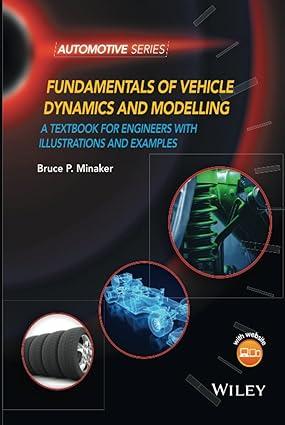Consider a vehicle with the following parameters: Mass: 2000 kg Wheelbase (a+b): 2.3 m Weight distribution (%f/r):
Question:
Consider a vehicle with the following parameters:
Mass: 2000 kg Wheelbase (a+b): 2.3 m Weight distribution (%f/r): 55/45 Anti-roll bar stiffness: front only, 5 kN/m (measured by deflecting one suspension while holding the other side fixed, this is in addition to the normal suspension stiffness)
Height of the centre of mass: 0.6 m (above the ground)
Track width: 1.4 m (left to right, same for both front and rear axles)
a) Assume the vehicle is in a steady state corner (i.e., the yaw rate is constant), where the lateral acceleration is 0.3 g to the right. Find the total lateral force provided by each axle (i.e., front and rear). Hint: think about the development of the bicycle model.
b) In order to accurately predict oversteer/understeer effects of suspension stiffnesses, a tire model more sophisticated than the simple linear model is necessary. Consider the tire model Y = f (????)(????Z − ????Z2), where Y are the lateral forces, Z are the normal forces, and f is a function related only to the slip angle. Use values of ???? = 0.9 and ???? = 6.0 ×
10−5/N. Use this tire model to estimate the lateral forces at each tire.
Hint: begin by computing the normal load on each tire. Assume that both front tires are operating at the same slip angle, as are both back tires.
Step by Step Answer:

Fundamentals Of Vehicle Dynamics And Modelling A Textbook For Engineers With Illustrations And Examples
ISBN: 98987
1st Edition
Authors: Bruce P. Minaker





